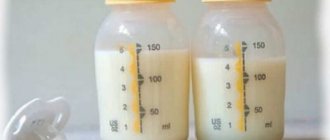Most women who give birth to a child are focused on natural feeding. But worries about whether the child has enough nutrition, whether the baby is getting enough to eat, are always present. These issues go away on their own when mature lactation is established. Mom understands this based on certain signs and her own well-being.
Breastfeeding is a multi-stage natural process that meets the baby's nutritional needs over a long period of time.
Signs of mature lactation
The active phase of lactation occurs differently for everyone. For some mothers it begins at 3 weeks of age, for others a month and a half after birth. How can a woman understand that lactation has established, what signs will indicate this? Among them:
- No hot flashes or swelling of the mammary gland.
- There are no tingling or painful sensations before breastfeeding.
- The feeling of fullness and the desire to express milk disappear.
- The breasts are soft before feeding, and there is often a feeling of lack of milk.
- The child's behavior was calm: he ate, then fell asleep.
- Equal time intervals between feedings are established, that is, the baby’s daily routine is formed.
Lactation in multiparous mothers is no different from the process of feeding first-time mothers. The woman just becomes more experienced. Don't panic if your chest feels empty. She latches on to the baby more often to quickly establish breastfeeding.
Usually, the formation of the active phase in mothers of second and subsequent children occurs more quickly.
What is this?
Lactation is the formation, accumulation and periodic excretion of milk. The phenomenon is observed not only in humans, but also in mammals. Thanks to the changes that occur in the body of a pregnant woman, she has the opportunity to breastfeed after the birth of her child.

Every expectant mother needs to know how breast milk is formed in women, since in the first stages of a baby’s development it helps him strengthen his immune system, and along with the product, important microelements enter the newborn’s body.
Phases of lactation development
The mammary gland goes through several stages in succession:
- Breast preparation occurs from the first days of pregnancy. The gland increases in size and volume from 200 g before pregnancy, and by the end of the pregnancy it can reach 800 g. Glandular tissue develops. It contains lactocyte cells, which are responsible for the production of milk. During this period, the first “milk” already appears. But the level of the hormone progesterone, which inhibits the release of the product, is high throughout pregnancy. By the end of the third trimester, its content decreases and immediately after birth colostrum appears in the milk ducts.
- Initial or transitional stage. The first valuable product for a newborn is colostrum. It populates the gastrointestinal tract with beneficial microorganisms, helps cleanse the intestines of meconium, and is rich in proteins. After 2-3 days, the colostrum becomes smaller and transitional milk appears. And “mature” comes at the end of the first month. The regulation of food production for a child is subject to a complex hormonal mechanism.
The process occurs under the influence of two hormones: oxytocin, which dilates the milk ducts and promotes their replenishment with milk, and prolactin, which works according to the feedback mechanism “how much milk the baby sucks, so much will come.”
The concentration of prolactin increases at night, so the mother is recommended to feed her baby at night in order to establish constant milk production.
- Active phase. The stage is formed by the end of the first month of the baby’s life. Lasts until lactation stops. During this period, the mother produces “mature” milk. As much milk enters the breast through the ducts as the baby sucked during the previous feeding. That is, according to his needs. At the same time, the woman ceases to feel hot flashes, tingling, bursting pain. Sometimes it feels like your breasts are empty because they are soft. At this time, lactation crises occur. This is a physiological condition when the baby’s need exceeds the contents of the breast. This condition resolves on its own; the female body initiates restructuring and increased lactogenesis. After about 5-6 days, feeding gets better. It is important not to switch the baby to artificial supplementary feeding during this period. It takes patience and time to normalize.
- Involution of lactation. The natural process of fading milk production. It starts when the child is 1.5 years old and ends at 3 years old. The less the baby nurses, the less milk is produced. The tissues of the mammary gland gradually degenerate: the ducts narrow, the alveoli disappear, the outlet openings on the nipple close, and the glands are replaced by adipose tissue. The mammary gland takes this path during the natural process of stopping feeding. The same thing happens when a woman is forced to stop lactation for various reasons: illness, transfer of the child to artificial feeding.
Ways to increase lactation
Taking hot baths and breast massage also helps increase lactation. When taking a shower, you should direct a stream of water to your chest, while making circular movements with your hand. Taking a bath is not only useful, but also pleasant.
There is also a folk method - hot tea with condensed milk and halva. These are miraculous remedies with which you can feel a rush of milk in your breasts in a matter of minutes.
If all these methods do not give the desired effect, then you should contact a specialist who, after certain examinations, will recommend taking special medications to increase lactation.
Thanks to active propaganda and information, most modern mothers themselves want to breastfeed their baby, because they realize that this is important and beneficial for the child. Sometimes circumstances develop in such a way that, despite a great desire to feed, lactation fades away and needs to be restored. How to restore lactation - 10 main recommendations -
Sooner or later the time comes when you need to stop breastfeeding your baby, and you need to somehow stop milk lactation. And this is where certain difficulties arise. Weaning a baby from the breast is not difficult (see how to do it simply). But how to make the milk go away? Unpleasant “chewing” sensations in swollen breasts, underwear wet from milk - which woman is not familiar with these sensations? Folk methods for stopping lactation and a list of drugs for quickly stopping lactation -
What drugs increase lactation?
Today there are many means to help increase lactation. The most popular are teas, they contain vitamins, herbs and minerals. For example, grandma's basket, lactogon, lactavit (here is a list of the most popular teas for lactation).
Many mothers prepare different formulas on their own, which should increase the amount of breast milk. This is not recommended. Only after consulting your doctor and certain examinations can you prepare and take various herbal decoctions.
Herbs such as lemon balm, nettle, dill, fennel, popular among nursing mothers, are included in lactation teas. They can also be used separately. It is recommended to take all herbal infusions and decoctions warm, because warm drinking increases milk production.
READ ALSO: How to increase breast milk lactation at home (folk remedies and tablets)
How to speed up the onset of mature lactation
A nursing mother can enhance lactogenesis by following the rules of natural feeding:
- Feed the baby on demand, starting in the maternity hospital.
- Avoid breastfeeding by the hour.
- Be sure to practice feeding at night.
- Eat nutritiously. The diet should include lean meats, fish, fresh vegetables, fruits, and dairy products.
- Maintain drinking regime.
- Avoid stress, overexertion, worries.
- Avoid physical activity that leads to fatigue.
- Get proper rest and practice naps during the day with your child.
- To walk outside.

If problems or questions arise during breastfeeding, the mother should contact a pediatrician or breastfeeding consultant, who will talk about possible solutions and give recommendations.
How to increase milk production
A decrease in lactation can occur as a result of stress, poor nutrition, insufficient fluid intake into the mother’s body, smoking or drinking alcohol, lactation crisis, etc. There are several ways to maintain good lactation.
Nutrition for a nursing mother
The diet of a nursing mother should include a sufficient amount of liquid (at least 2 liters per day). Nutrition should be balanced and include healthy and natural foods. The daily menu contains a sufficient amount of:
- proteins (meat, fish, dairy and fermented milk products);
- carbohydrates (cereals, bread, cereals);
- fats (vegetable oil, butter);
- vitamins and microelements (fruits, vegetables, nuts).

It is advisable to limit consumption of:
- products that can cause allergies (citrus fruits, cocoa, chocolate, eggs, strawberries);
- foods that can cause increased gas formation (legumes, grapes, cabbage);
- products that contain caffeine (coffee and tea);
- hot seasonings and spices that can spoil the taste of milk (pepper, garlic).
Products that help increase lactation:
- herbal teas;
- soups and broths;
- nuts;
- dairy products;
- juices;
- watermelons;
- carrot;
- dill.
For feeding to be successful, eat something nutritious half an hour beforehand, and drink a glass of warm liquid 15–20 minutes before.
Correctly attaching a baby to the breast
From the very beginning of communication with your baby, try to put him to your breast correctly. This will avoid cracked nipples and lactostasis, and will help to establish proper and sufficient lactation. With the correct position during feeding, the baby grasps not only the nipple, but also its areola. The baby's lower lip turns outward and his nose touches his chest.

The mother should not experience pain when feeding
If during feeding the mother experiences pain in the nipple area, cracks form on them. This means that the baby is not latching onto the breast correctly. To help, open the baby's mouth wide by pressing on the chin and at this moment try to immerse the nipple and areola as much as possible inside. Make sure everything is done correctly. Every time your baby is unable to latch onto the breast correctly, persistently push for a safe latch. Over time, the baby will learn.
Hot shower and breast massage

In order for feeding to be successful, you can first take a hot shower and massage your breasts. Massage movements are performed as follows:
- Hold your chest from below with one hand, and with the other make light circular movements clockwise from the periphery to the center.
- After this, tilt your body parallel to the floor and shake your chest slightly.
Repeat this procedure 2-3 times and start feeding. Milk comes out much easier.
Drugs to increase lactation
| Drug name | Compound | Side effects | Contraindications | approximate price |
| Laktogon |
| Allergic reactions are possible. |
| 251 rub. for 20 tablets |
| Mlekoin |
| The medicine does not cause adverse reactions if used correctly, since it belongs to the category of homeopathic medicines. | Individual intolerance to components. | 142 rub. for 10 g |
| Apilak | Lyophilized royal jelly. | Sleep disorders and allergic reactions. |
| 242 rub. for 25 tablets |
| Milky Way |
| No data. | Individual intolerance to the components of the drug. | 283 rub. for 200 g. |
Medicines are used only as a last resort if other methods do not help. In addition, to increase lactation, you can use specialized teas, such as HIPP, Babushkino Lukoshko, Humama, Lactaphytol, Lactavit and others.
Reviews of methods to increase lactation
I just drank a lot of hot liquid. Usually it was tea or chicken broth. The liquid must be hot. Not scalding, of course, but not barely warm either. I drank a large mug of tea or broth and immediately put the baby to the breast. Lactation immediately went with a bang. This is how we overcame milk crises.
shmvet
https://otzovik.com/review_80465.html
The most important thing is not to be nervous, eat well and get plenty of rest. Get in the mindset that the baby needs mother’s milk, and you’ll have time to do something later, when lactation improves. Try drinking carrot juice, if, of course, your baby responds well to it. When I was having problems, it seemed to me that it was carrot juice that increased my milk supply.
SoLne4ka
http//deti.mail.ru/forum/nashi_deti/kormim_grudju/kak_uvelichit_laktaciju/?page=2
It is imperative to put the baby to the breast at night from 3 o’clock to 6 o’clock. It is at this time that the “milk hormone” is produced and an “order” is made for the amount of milk for the next day. Feed the baby on demand. Milk production is increased by hot drinks, hot showers, and physical activity.
Irina
https://deti.mail.ru/forum/nashi_deti/kormim_grudju/kak_uvelichit_laktaciju/?page=2
I drank milk infused with walnuts: pour 1 glass of walnuts into 1 liter of hot milk, leave in a thermos for 2-3 hours and drink throughout the day - it helps.
vasan
https://www.babyplan.ru/forums/topic/40419-malo-moloka-uvelichenie-laktatsii/#ixzz4xSCqLxcD
Lactovit or Lactofitol Evalar tea, milk did not take long to arrive, it helped a lot, nothing else helped.
Evgeniya
https://www.babyblog.ru/community/post/laktaphitol/242195
When does lactation begin?
Milk may not be observed immediately after birth; it may take several days. As a rule, the “hot flash” is recorded on the 2-3rd day. At first, milk is released in very small quantities, only a few tens of grams. Already on the 3-4th day, the volume of the product increases sharply, there is enough of it for the breastfeeding process to take place fully.

Did you know? The iron contained in breast milk is absorbed by the child much better than the same element contained in any other product, and its formula perfectly matches the needs of the child's body.
Delays occur when milk begins to be produced in noticeable volumes on the 5-6th day. This phenomenon is more often recorded in mothers who gave birth for the first time. This does not necessarily indicate that problems are possible in the future, the body just needs more time to “build up”. This is especially true for women who have undergone a caesarean section.
The first milk is considered “preparatory”, the composition of which in individual elements differs from the “mature” one, secreted only on the 10-12th day. During this period, the allocation of “product” for the baby comes into relative agreement with the main needs of the newborn.
How to establish lactation? Foods that affect lactation
In case of lactation dysfunction, you can resort to one of several methods that will normalize the production of breast milk: using specially developed medications or naturally. It is recommended to use the first method only if the second method does not bring the desired result, which includes good nutrition, a healthy lifestyle, and only after the recommendation of a doctor.
It is worth drawing your attention to the fact that during lactation, a young mother should drink a large amount of liquid , at least two liters during the day. You need to carefully consider your diet, from which you need to exclude all harmful foods. Mandatory components of the nurse's diet should be:
- cheese;
- fermented milk products: yogurt, cottage cheese, fermented baked milk, kefir or yogurt;
- nuts;
- protein products: eggs;
- seafood: carp, pollock, carp, pike perch or hake;
- lean meat varieties: rabbit, veal or chicken.
The following should be excluded from the diet of a young mother:
- vegetables, berries and fruits that can contribute to the development of allergies: raspberries, black currants, strawberries, citrus fruits, tomatoes;
- carbonated drinks;
- products containing dyes and additives, preservatives;
- spices;
- roast;
- fatty.
Preparing for the period
When preparing for the lactation period, it is necessary to understand the importance of breastfeeding so that a strong psychological attitude is developed for prolonged breastfeeding, that is, naturally.

Did you know? Breast size is absolutely not important. Women with small breasts can feed their children just as successfully as mothers with a gorgeous bust. The presence of implants is not an obstacle to successful feeding.
From the fourth month of pregnancy, it is recommended to do a contrast shower for the breasts, and then rub the nipples with a hard terry towel. This manipulation helps prevent stretch marks on the bust, making the skin in the nipple area rougher, which will avoid cracks; you can make lotions from a decoction of oak bark.
Sports during lactation
Of course, playing sports is extremely useful, but after giving birth you need to approach physical exercise very wisely , carefully listening to your body, how it reacts to certain exercises.
Basic principles of playing sports during lactation:
- It is recommended to start classes with light loads. If the birth took place without any complications and naturally, then you can start physical activity a few weeks after the birth of the baby.
- First of all, it is recommended to pay attention to exercises that help strengthen the abdominal muscles. They allow you to tone the muscles, get rid of the consequences of constant stress on the spine, and also return the uterine muscles to their original position.
- After a week or two, you can add body turns, arm swings, bending, and squats. Exercises for the abdominal muscles need to be strengthened.
- At the same time, it is recommended to start doing exercises to strengthen the pectoral muscles. Such exercises not only help maintain breast shape, but also help increase lactation.
It is worth noting that it is recommended to do all physical exercises immediately after feeding , since during exercise lactic acid, which may be contained in milk, is abundantly released.
- Water. During physical exercise, it is necessary to increase the amount of fluid consumed to compensate for its loss.
- Exercise should be fun. You should not perform exercises by force or if you are not in the mood.
- Quiet mode. Exercises should not be overly forceful or intense. Your main goal should not be to pump up muscle mass, but to get your body in order.
Recommended types of sports activities:
- Step, hoop, fitball - exercises with them are quite simple and do not cause discomfort, do not strain the body, allowing you to simply keep it in good shape;
- Shaping or aerobics - include fairly active complex exercises that are aimed at strengthening muscles and losing weight. These physical exercises can be easily done at home;
- Yoga and Pilates - exercises allow you to evenly distribute the strength load across all muscle groups, improve your mood and tone up. These exercises are primarily aimed at relaxation, so they do not require significant effort;
- Walking is perhaps the most accessible and simplest form of exercise. When walking with a stroller, a woman should walk as quickly and as intensely as possible in order for the walk to be as beneficial as possible;
- Swimming perfectly tones and trains the muscles of the whole body, without loading the joints and spine.
Mistakes of young mothers
Many young mothers, due to their inexperience or simply due to ignorance, make some key mistakes when breastfeeding. The main ones are given below.
- Immediately after birth, you cannot establish a feeding schedule, since the newborn himself regulates when and how much he should eat. The appearance of the schedule is optimal during mature lactation, approximately 14-21 days after the birth of the baby.
- It is not recommended to supplement your baby with artificial formula, as this is fraught with unpleasant consequences. In particular, sucking a pacifier is somewhat easier than a nipple, and the taste of formula is usually superior to breast milk, so there is a high risk that the child will begin to demand a substitute. Mixtures can also cause side effects, including colic, allergies, problems with the immune system and digestive system.
- You should also not give your baby extra water, since milk is 90% water, and the dose the baby receives is enough. When there is a feeling that the baby is thirsty, it is better to carry out unplanned feeding, since an addiction to water can lead to the child’s refusal to breastfeed.
- It is important to understand that crying is not always caused by hunger. Most often, through crying, the baby attracts attention; it can be caused by colic, headaches and stomach pains; the child may be scared or simply bored.
- Dense and firm breasts do not indicate a significant amount of milk. Lumps in the bust area may indicate the onset of lactostasis. Under normal conditions, the breasts should remain soft, and evidence that everything is in order is the absence of unpleasant sensations.
- It is better to give up the pacifier, because the baby's sucking reflex is fully satisfied by the nipple. In case of crying, you need to identify and eliminate the cause of the irritation, and not try to calm the child with a pacifier.
- In the absence of a sufficient number of reasons, expressing milk is not recommended, since the most important part of the product is lost. An alternative may be supplementary feeding.
- You should not introduce complementary foods to your baby too early; this should be done no earlier than six months of age. Otherwise, allergic reactions and stomach problems may develop, and difficulties with physical development are possible in the future.
- There is no real benefit in carrying out control weighing of the baby. The child consumes too little milk; sensitive scales will be required to establish weight fluctuations, and household scales rarely provide true information. It is enough to carry out this procedure once a week.
- It is better for mothers not to rely on irrelevant methods for determining weight gain in children, which many pediatricians resort to. It is better to check with modern sources.
Lactation in pregnant and postpartum women is a natural process with many nuances and rules that must be followed. However, with the right approach and following these recommendations, problems with breastfeeding should not arise.

Nutrition Baby nutrition Breastfeeding










